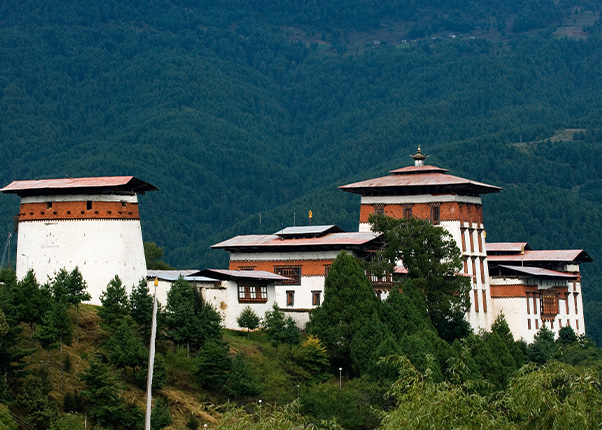
Bumthang Valley, often considered the spiritual heart of Bhutan, graces visitors with its ancient Buddhist temples and monasteries.
This captivating 11-day journey includes a three-day trek through the scenic Bumthang countryside, where you’ll traverse quaint villages and immerse yourself in the rustic allure of Bhutanese rural life.
Upon your arrival at Paro airport, our Ing Travel Company representative will greet you and facilitate your transfer to the hotel. Enjoy your first evening in Paro at your leisure. Overnight stay at a Paro hotel.
Embark on a full day of sightseeing in Paro. In the morning, explore Ta Dzong, originally built in 1651 as a watchtower and later transformed into the National Museum. The museum houses a collection of ancient Bhutanese art, historical artifacts, weapons, coins, stamps, and a small natural history exhibit.
Continue to Rinpung Dzong, constructed in 1646 to safeguard the valley from Tibetan invaders and now serving as the district administration offices and a monastic community.
After lunch, venture up the valley to Drukgyel Dzong, erected in 1646 to commemorate Shabdrung Ngawang Namgyal’s triumph over Tibetan invaders. If time allows, visit Kyichu Lhakhang, a 7th-century monastery. Overnight stay at a Paro hotel.
Drive to Thimphu, the modern capital of Bhutan. En route, make a brief stop to admire the ancient fortress of Semtokha Dzong, dating back to 1627, which stands atop a small hill.
After lunch, time permitting, visit the National Memorial Chorten (built in memory of Bhutan’s third king and as a symbol of world peace), the National Institute of Traditional Medicine (exterior only), the Institute for Zorig Chusum (where students master Bhutan’s 13 traditional arts and crafts), the National Library (housing a comprehensive collection of Buddhist literature), and Tashichhodzong (a fortress housing government ministries, His Majesty’s secretariat, and the central monk body). Overnight stay at a Thimphu hotel.
Continue to Rinpung Dzong, constructed in 1646 to safeguard the valley from Tibetan invaders and now serving as the district administration offices and a monastic community.
After lunch, venture up the valley to Drukgyel Dzong, erected in 1646 to commemorate Shabdrung Ngawang Namgyal’s triumph over Tibetan invaders. If time allows, visit Kyichu Lhakhang, a 7th-century monastery. Overnight stay at a Paro hotel.
Drive to Trongsa via the Dochu-la pass (3,088m).
On clear days, you can enjoy breathtaking views of Bhutan’s highest peaks from the pass, including Masagang, Tsendegang, Terigang, Jejegangphugang, Kangphugang, Zongaphugang, and Gangkar Puensum, Bhutan’s highest peak.
Continue to Wangduephodrang town, where you’ll have lunch, and then proceed to Trongsa via the Pele-la pass (3,300m), traditionally marking the boundary between eastern and western Bhutan.
Overnight stay at a Trongsa lodge.
Start your day with a visit to the impressive Trongsa Dzong, the ancestral home of Bhutan’s royal family.
Also, explore Ta Dzong, originally constructed as a watchtower to protect Trongsa Dzong. Proceed to Bumthang, where you will visit Jakar Dzong, a 17th-century fortress, and Kurje Monastery, built in the 17th century at the site where Guru Padmasambhava meditated in the 8th century, leaving an imprint on the rock.
Overnight stay at a Bumthang lodge.
Today, your trek begins.
The route covers 14 km over approximately 6 hours, following the Chamkhar Chu (river). You’ll traverse meadows, blue pine forests, and bamboo thickets, passing by numerous villages and temples. It’s a relaxing and easy day.
Camp overnight at a village (2,900m).
Cover 19 km in about 7-8 hours.
The trek takes you gradually uphill through a juniper forest to Phephe-la pass (3,340m). From there, the path descends into Tang Valley, leading to Ogyenchhoeling village (2,850m).
Camp overnight by the riverside near the village.
Journey 11 km in roughly 4 hours. In the morning, visit Ogyenchhoeling Palace, a beautiful private mansion housing a small eco-museum.
Then, drive to Jakar (Bumthang) following the Tang Chu until you reach the main road. En route, visit Mebar Tso Lake, a sacred site where Terton Pema Lingpa is believed to have discovered religious treasures in the 15th century.
Overnight stay at a Bumthang lodge.
Start your day with a visit to Jambey Lhakhang, founded in the 7th century by Tibetan king Songtsen Gampo, who is considered to be the reincarnation of Jambey (Avalokitesvara), the Bodhisattva of Compassion.
Across the river, explore Tamshing Lhakhang, which contains fascinating old religious paintings. Drive to Punakha with lunch en route.
Overnight stay at a Punakha hotel.
Today, you’ll return to Paro.
This will be a leisurely day, and you’ll arrive in Paro by lunchtime. Enjoy free time for relaxation or some last-minute shopping.
In the evening, take a stroll around Paro’s market. Overnight stay at a Paro hotel.
After an early breakfast at the hotel, you’ll be driven to the airport for your flight to your onward destination.
Fill the form and we will be in touch.